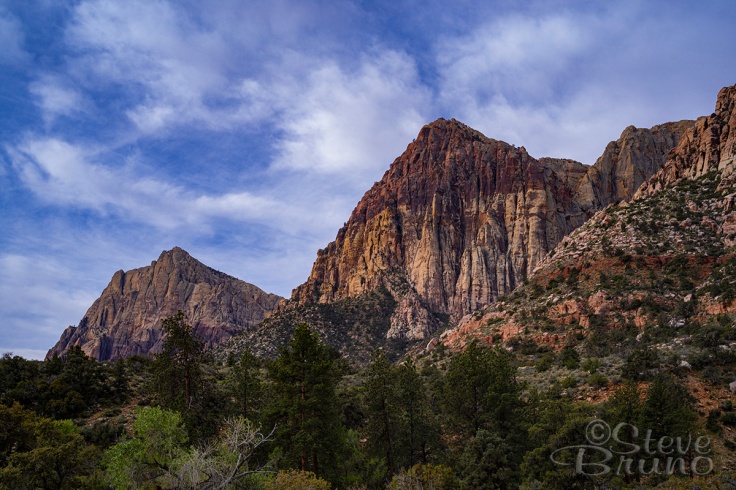Red Rock Canyon has a bit of a deceiving name. Unlike Zion or Grand Canyon, there is not one distinct canyon running through the middle of the park. Instead, it is a long linear steep cliff with canyons that disect the cliff in several places. From the road, the geology gives the impression that these canyons would be much the same. Venture in, however, and all the differences become apparent. Some have water beyond the mouth of the canyon, but can be dry well into the canyon. Year round water in some, but dry creek bottoms are more common. Waterfalls can be found in most canyons, seasonally, but there are no real similarities between them. Brothers, not twins.

The trails into the canyons are similar – hike about a mile or so in open desert until you reach the mouth of the canyon, then follow the path of least resistance. The official trails don’t really go into the canyons, so following the wash bottoms is the route further in. Eventually, there is a bunch of rock hopping, tree branch ducking, and sliding between boulders. Just the kind of workout someone on the mend needs. Like me! Even with restrictions in place, getting out for exercise has been allowed here. The road to many of these canyons has been closed to vehicles, making it more work for people to access, thus keeping the crowds down. A demanding workout with fresh air, beautiful scenery, and almost no people has been a win-win-win scenario. For me, healthy legs means healthy heart and lungs, and less chance of getting sick.

All the images here are from my two recent hikes into neighboring canyons. On one, I had cloudy conditions most of the day, and the soft light was essential for getting the photos I did. On the other, clouds were predicted for most of the day, but soon vanished. Temperatures down in the desert were pushing triple digits, but a breeze was coming through and it was very comfortable here.
One of the things I’ve noticed through the years is the change in the water into springtime. After the snow has melted, and the creek flows decrease, algae forms in the pools, and as these pools dry up, green tinted rocks remain. I even found algae forming on a waterfall.
On the second hike, I started getting photos of something I don’t normally come across – tiny critters. I was sitting in the shade of a large tree cooling my feet in the water when I observed a brightly colored dragonfly. It had chosen a tiny exposed root as its perch, and after ten minutes, it was still there. It would fly away occasionally, but always return within three seconds. After clearing away some larger rocks so I could lay on my stomach somewhat comfortably, I inched closer with my favorite macro lens. By the time I finished, I was about 3 inches away and could now observe that the dragonfly was in the middle of lunch. Every time it jumped away and returned, it had some tiny insect in its mouth. He could have cared less about me. Shortly after leaving that area, I came across a lizard on a rock. I knew it wasn’t going to have the same tolerance for me as the dragonfly, but I managed a few close-ups without it moving a millimeter. It has also been frog hatching season, and I managed to capture this tiniest of frogs. I could have picked up any one of these rocks with one hand, but the pine needle in the back really gives it a frame of reference.
For now, the creeks still have water but the levels have been diminishing with each passing week. My favorite part of spring has to be the redbud trees in bloom. I wanted to capture them with partly cloudy skies, but the full sunshine actually worked well.
Stay healthy everyone!

May 3, 2020 at 11:17 am
Hi, lucid description and enjoyed your escapade. Thanks and much appreciated for sharing!
LikeLiked by 1 person
May 3, 2020 at 11:27 am
I’m glad you enjoyed the post, and thank you for taking time to comment on it!
LikeLiked by 1 person
May 3, 2020 at 6:04 pm
Beautiful shots, Steve. I loved seeing the critters. Glad you are on the mend. 🙂
LikeLiked by 1 person
May 3, 2020 at 6:49 pm
Thank you, Eliza! As you know, critters aren’t usual subjects for me. I think they’re aware of something going on with humans nowadays. I’ve seen more than usual lately and they don’t appear to be as afraid as I might expect.
LikeLiked by 1 person
May 4, 2020 at 1:29 pm
Thank you for sharing this. Red Rock Canyon looks amazing and your photos are beautiful!
LikeLiked by 2 people
May 5, 2020 at 10:20 am
While some places have easy-to-get-to must-see iconic spots that are photographed and posted by the masses, Red Rock has none of those. Instead, I find I have to just explore the park, and the beauty presents itself. Thank you for your comments, Leah!
LikeLiked by 1 person
May 5, 2020 at 2:04 pm
Insight is 2020…The top picture above is seeing all of your other beautiful pictures. What an auspicious place to BE…
LikeLiked by 1 person
May 6, 2020 at 7:25 am
Yes, that top picture really does look down upon all the rest, and is a truly amazing place to be!
LikeLiked by 1 person